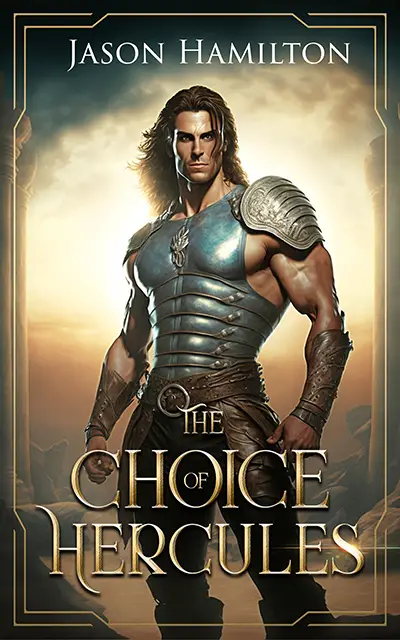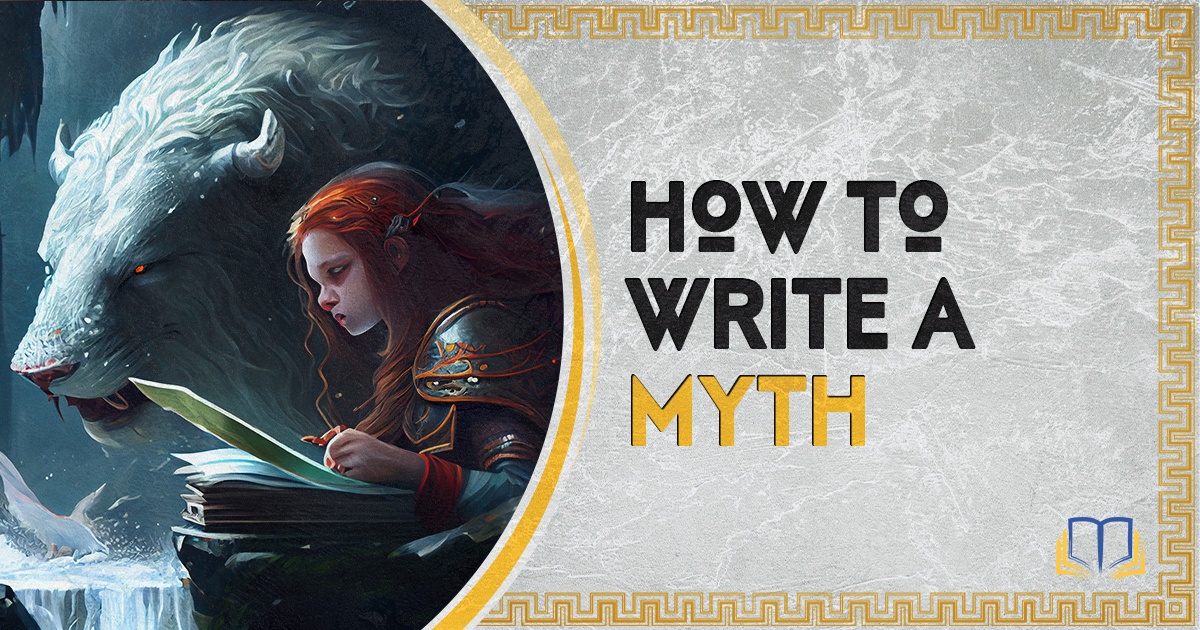Ever dreamt of crafting a mythic tale, yet uncertain how to start? Writing a myth can be daunting and intimidating. But it doesn’t have to be.
By following these simple steps – from brainstorming ideas through researching, creating characters and writing the actual story – anyone can create an original work that will live on in time.
So don’t wait any longer; start your journey today by learning how to write a myth.
What is A Myth in Storytelling?
A myth is a traditional story that explains the beliefs of a culture or society. Myths are usually set in an ancient time and involve gods, goddesses, heroes, and other supernatural beings. They often explain natural phenomena such as storms, floods, and eclipses.
You’ll see this a lot in creation myths, for example.
Mythological tales also provide explanations for why things happen the way they do in life. For example, many cultures have myths about how death came into existence or why certain animals behave in certain ways.
Myths pervade all forms of human expression, from literature and art to music and film; they are a means for societies to impart moral values and lessons. Storytellers use myths to teach their audiences valuable life lessons by providing examples of what happens when people make good decisions versus bad ones.
Key Takeaway: Writing a myth is an opportunity to explore creative storytelling and impart valuable life lessons; research existing myths, brainstorm ideas, create characters, write your story and revise/edit it for quality.
How To Write A Myth: 5 Steps
Now let’s walk through the five steps that I recommend to write a myth.
Step 1: Brainstorm Ideas
Brainstorming ideas for a myth can be an exciting and creative process. Contemplate the protagonists, background, progression of events, and motifs you wish to delve into in your narrative. Consider what makes your myth unique from other stories or ancient myths that have been told before.
When brainstorming characters for your myth, consider their role in the story as well as any special characteristics they may possess. Think about the will communicate with one another and how their behavior might shape the eventual result of your tale. You could also create a character who is based on someone you know or draw inspiration from mythology or literature.
The setting of your myth should be carefully considered too. Where does it take place? Is it in a mythical world or one more closely resembling our own? How do different elements such as time period, climate, geography etc., impact the story? What sort of ambiance is being sought to be generated?
Plot is another key element when brainstorming ideas for a mythic tale. What events occur throughout the narrative? Are there any unexpected turns of events that might take the story in an unforeseen direction? How does each event contribute to driving forward the main conflict of your story?
Finally, consider what themes you want to explore within your mythic tale; this could include anything from morality and justice to love and loyalty. These themes can help give depth and meaning to your storytelling while helping readers connect with its message on an emotional level.
Once you’ve got a few ideas brewing, it’s time to plunge into the depths of mythic tales and investigate their roots. Researching these stories will help you craft your own unique myth that resonates with readers.
Step 2: Research Myths
Researching and exploring existing myths can assist in understanding certain mythical components and construction, as well as give impetus for the formation of fresh narratives.
To begin researching, start by looking into different cultures and time periods to get an idea of what types of myths exist. Look at ancient Greek or Roman mythology, Norse mythology, African folktales, Native American legends, or any other culture’s traditional stories. Investigating these tales will afford you a more profound comprehension of their structure and the archetypes that emerge in them.
You can also look into specific gods or heroes from various mythologies to learn more about their roles in the stories. Investigate Thor from Norse mythology, for instance; his escapades with Loki and Odin provide insight into his character and the motivation behind his actions in the narratives.
It may also be helpful to research some common themes found in many different mythologies such as creation stories or hero’s journeys so that you can incorporate those elements into your own work. Additionally, reading books on comparative mythology could help because it gives insight into how similar themes are expressed across multiple cultures. And this could spark ideas for your own story-telling.
After researching the many myths and legends of old, you can begin to create your own characters.
Key Takeaway: Mythology is a rich source of ideas and structure for creating stories, from gods and heroes to common themes across cultures. Researching these can help inform your own writing.
Step 3: Create Characters
Formulating protagonists is a key factor of narrative-crafting. Characters are the people or creatures that inhabit your story and give it life. They should be believable, with their own motivations and flaws. It’s important to consider each character’s role in the story, as well as how they will interact with one another.
Think about what makes them one-of-a-kind, compelling and captivating. What kind of personality do they have? Are they brave or cowardly? Do they possess any exceptional talents or powers? Explain why they act as such and what occurrences may be more influential to them than others.
Also consider how your characters look physically – what color hair do they have? How tall are they? What type of clothing do they wear? Eyes? Eyeballs? All these details can help bring your characters to life for readers.
You should also think about how each character fits into the overall plot of your story. Does this person drive the action forward, or provide comic relief when things get too intense? Will there be conflict between two characters over something that happened in their pasts, or will two people become friends despite their differences? The relationships between different characters can add depth to your narrative and make it more engaging for readers.
Finally, don’t forget about antagonists. Villains are just as important as heroes in stories; without someone standing in opposition to our protagonist(s), there would be no tension driving us towards resolution at the end of a tale. Think carefully about who you want opposing forces to be: perhaps it’s an evil wizard trying to take over the kingdom, or maybe it’s simply a bully on school grounds who makes life difficult for everyone around him/her/them. Whatever form these villains take on, make sure you create fully fleshed out individuals so readers can understand where their motivations come from (even if those motivations aren’t always noble).
Once you have fashioned protagonists, it’s time to go on the next venture and craft a tale of exploration, bravery, and revelation.
Key Takeaway: Write unique and interesting characters with backstories that explain their motivations, create relationships between them to add depth to your story, and don’t forget antagonists who provide tension in the narrative.
Step 4: Write the Myth
Myth writing is an age-old practice of artistry, involving the composition of tales featuring deities, beasts, champions and other fabled beings. It involves creating stories with gods, goddesses, monsters, heroes and other mythical creatures. To write mythology, it’s important to have a clear idea of the characters and plot before you begin writing.
Once you have all the elements of your tale figured out, start writing. Begin with an introduction that sets up the world and introduces readers to its inhabitants before diving into more detailed descriptions of events as they unfold throughout the story. Use vivid language to bring scenes alive while also making sure not to bog down readers with too much detail at once; keep things moving along at a steady pace so there’s always something new happening on every page.
Once you have crafted the story of your myth, it is time to ensure that it meets all the necessary criteria for a successful piece. With careful editing and revision, you can make sure that your myth stands out from the crowd.
Key Takeaway: Create unique characters with distinct motivations and use vivid language to bring your myth alive, then edit and revise for a successful story.
Step 5: Edit & Revise
Editing and revising your myth is an important step in the writing process.This step is essential if you want readers to be able to enjoy reading through your work without getting bored or confused due any typos or inconsistencies within the text itself. It’s essential to ensure that your story flows well, characters are developed properly, and there are no inconsistencies or errors.
Start by reading through your work several times. This will help you identify any potential issues with plot development or character arcs. Make sure each scene transitions smoothly into the next one and that all elements of the story fit together logically. Pay attention to how dialogue is used as it should be natural-sounding yet convey the emotions of each character effectively.
Look for any spelling or grammar mistakes throughout your text as well as typos that could affect readability or cause confusion among readers. Check if words have been used correctly and make sure they fit within context appropriately too.
You can also ask others for feedback on your work before publishing it publicly. Consider having a professional editor review your manuscript if possible; their expertise can aid in ensuring accuracy in both content and formatting prior to publication day.
FAQs On How to Write a Myth
How do you create a myth?
Myths are stories that have been passed down through generations, often to explain the unknown. To create a myth, start by deciding on a theme or topic you want to explore. Brainstorm ideas and draw inspiration from other myths and folklore. Create characters with unique personalities and abilities, then craft an exciting plot full of twists and turns.
What does good myth writing include?
Good myth writing should include a captivating story with interesting characters, vivid descriptions of the setting and action, creative plot twists and turns, suspenseful moments that keep readers engaged, meaningful themes or morals woven throughout the narrative, and an overall structure that is both logical and satisfying.

This is a short story that takes place in Greek Mythology (and is part of my shared universe of mythic stories).
It’s a faithful adaptation of a little-known myth that is perhaps my favorite about Hercules. Check it out!
Final Notes
Writing a myth can be an exciting and rewarding experience. Whether you’re writing your own original story or retelling an ancient one, the process of creating characters, researching myths, and crafting a narrative is sure to bring out your creative side.
With some practice and dedication, anyone can learn how to write a myth that will captivate their audience.
Who knows what wondrous tales you’ll weave when you set your pen to paper and craft a myth
About the Author
Chioma Ezeh is an author, digital marketer, business coach, and the founder of chiomaezeh.com, a blog that teaches how to build successful online businesses.



